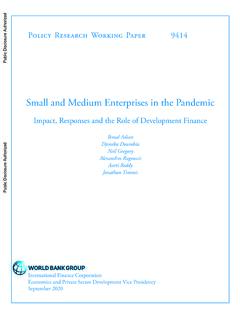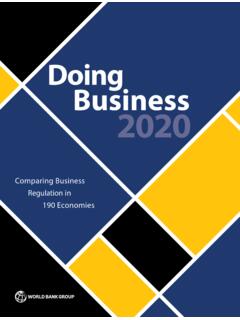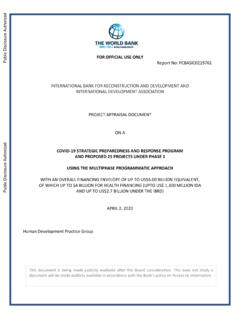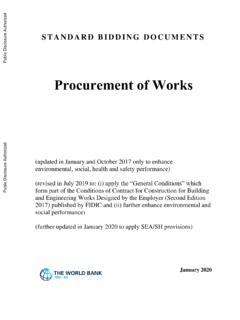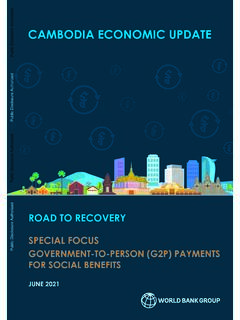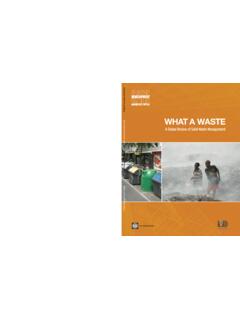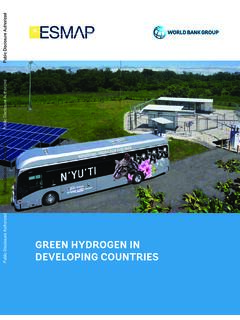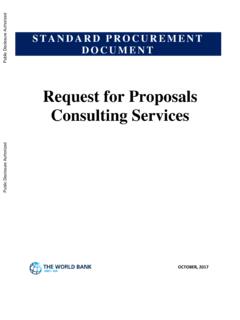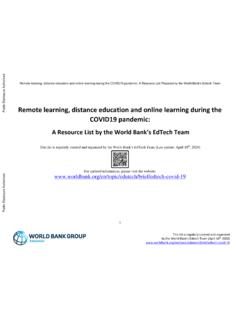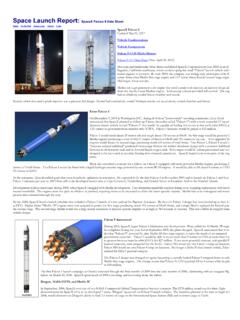Transcription of Understanding the Cost of Achieving the Sustainable ...
1 Policy Research Working Paper9146 Understanding the Cost of Achieving the Sustainable Development GoalsDana Vorisek Shu YuEquitable Growth, Finance and Institutions Practice Group February 2020 Produced by the Research Support TeamAbstractThe Policy Research Working Paper Series disseminates the findings of work in progress to encourage the exchange of ideas about development issues. An objective of the series is to get the findings out quickly, even if the presentations are less than fully polished. The papers carry the names of the authors and should be cited accordingly. The findings, interpretations, and conclusions expressed in this paper are entirely those of the authors. They do not necessarily represent the views of the International Bank for Reconstruction and Development/World Bank and its affiliated organizations, or those of the Executive Directors of the World Bank or the governments they Research Working Paper 9146 This paper presents a review of studies that estimate the cost of Achieving the Sustainable Development goals .
2 Although the Sustainable Development goals provide useful bench-marks for fiscal authorities and donors, typical cross-country costing exercises can be misleading, for a variety of reasons: double counting, sensitivity to underlying assumptions, downplaying the critical role of policy and institutions in advancing toward the goals , failure to discount costs or consider operation and maintenance costs in a consistent manner, and overlooking the tendency for different types of Sustainable Development Goal related spending to have distinct effects. Recent costing studies by the World Bank Group have been developed to minimize the drawbacks of earlier studies. The paper also briefly reviews how the World Bank Group engages with stakeholders on the Sustainable Development goals agenda.
3 This paper is a product of the Equitable Growth, Finance and Institutions Practice Group. It is part of a larger effort by the World Bank to provide open access to its research and make a contribution to development policy discussions around the world. Policy Research Working Papers are also posted on the Web at The authors may be contacted at and the Cost of Achieving the Sustainable Development goals Dana Vorisek and Shu Yu* Keywords: economic development, Sustainable development, development policy JEL Classification: O1, O19, O2 _____ * Vorisek (World Bank, Prospects Group; and Yu (World Bank, Prospects We are grateful to Ayhan Kose and Franziska Ohnsorge for guidance and to ShantayananDevarajan, Delfin Sia Go, Ceyla Pazarbasioglu, Marco Scuriatti, Umar Serajuddin, Jos Verbeek, and many othercolleagues at the WBG for feedback and background materials.))
4 The findings, interpretations, and conclusionsexpressed in this paper are those of the authors. They do not necessarily represent the views of the institutions theyare affiliated I. Introduction The Sustainable Development goals (SDGs) are a universal call to end poverty, protect the planet, and ensure shared peace and prosperity. They are a key component of the 2030 Agenda for Sustainable Development, an initiative adopted in 2015 by all UN member states. The SDGs encompass 17 goals , each with multiple underlying targets and associated data indicators, to be achieved by 2030. The SDGs replaced the Millennium Development goals (MDGs), the set of eight goals that shaped the international development agenda during 2000-15.
5 The twin goals of the World Bank Group (WBG) set the institution s priorities within the SDG framework. In 2013, the WBG adopted the twin goals of ending extreme poverty and boosting shared prosperity. Specifically, the goals are to lower the share of the global population living in extreme poverty to 3 percent and raise the income of the bottom 40 percent of each country s population in a Sustainable manner by While global agreement on the SDGs provides a common international framework for development ambitions, the WBG s goals set the institution s priorities within that framework. The WBG s financial products, technical assistance, and international initiatives all contribute to the global effort to achieve the SDGs.
6 Progress toward the SDGs has been uneven. In some of the indicators tracked as part of the SDG framework, there has been clear progress (World Bank 2018a). The number of people living in extreme poverty ( , below $ a day) fell by more than 1 billion between 1990 and 2015 (SDG 1). Globally, more than 95 million fewer children were stunted in 2016 than in 1990 (SDG 2). Life expectancy at birth, an important measure of good health and well-being (SDG 3), rose from years in 1990 to years in 2017. Access to electricity reached 89 percent of the world s population in 2017, up from 83 percent in 2010 (SDG 7; IEA et al. 2019). Yet progress has also been insufficient to meet the 2030 targets in some areas.
7 There are still about 1 billion people, mostly in rural areas, without electricity. Worldwide, more than half of children do not meet minimum proficiency standards in reading and mathematics (United Nations 2018). As of 2015, billion people still did not have access to even basic sanitation services. Recent data indicate that climate change has contributed to a rise in the number of undernourished people (United Nations 2018). Developing strategies to accelerate progress in these areas requires an Understanding of the costs connected with meeting the goals . The WBG has played a leading role in the estimation of investment needs. First developed in the context of the MDGs, costing exercises provide benchmarks for donors and national fiscal authorities in their budgeting These studies have been undertaken by the WBG at the global, regional, and sectoral levels.
8 A major recent costing exercise by the World Bank estimates that low- and middle-income countries face investment needs of $ trillion to $ trillion per 1 The first of the WBG s twin goals is to reduce the incidence of extreme poverty, defined as living on less than $ per day, to no more than 3 percent by 2030. Target under SDG 1 was originally to eradicate extreme poverty, defined as living on less than $ per day, by 2030. It has since been revised to eradicate extreme poverty using the $ per day poverty line. 2 During the same period, the World Bank and IMF produced a series of Poverty Reduction Strategy Papers to analyze countries financing needs and major sources of financing ( ).
9 A few studies have pointed out the caveats of MDGs costing exercises ( , Clemens, Kenny, and Moss 2004; Devarajan 2015). 3 year ( percent of their combined GDP) between 2015 and 2030 to meet infrastructure-related SDGs, depending on policy choices (Rozenberg and Fay 2019). Costing exercises have also been carried out by other international institutions, but the results are not easily T he IMF estimates that additional spending of about $ trillion (2016 US$) per year during 2019 30 is required to make meaningful progress toward the SDGs related to infrastructure in low-income developing economies and emerging market economies combined, and another $ trillion for the SDGs related to health and education (Gaspar et al.)
10 2019). The UN estimates that $5 trillion to $7 trillion per year between 2015 and 2030 is needed to achieve a set of SDGs globally, with the estimates being $ trillion to $ trillion per year in developing countries, mainly for basic infrastructure, food security, climate change mitigation and adaptation, health and education (UNCTAD 2014). The World Health Organization (WHO) estimates the additional annual investment needed to meet the SDG on health in low- and middle-income countries is about $370 billion (Stenberg et al. 2017; WHO 2017). The Food and Agriculture Organization (FAO), the International Fund for Agricultural Development (IFAD) and the World Food Programme (WFP) jointly estimate that an average of $265 billion per year is needed during the period 2016 30 to sustainably end hunger (FAO, IFAD, and WFP 2015).
